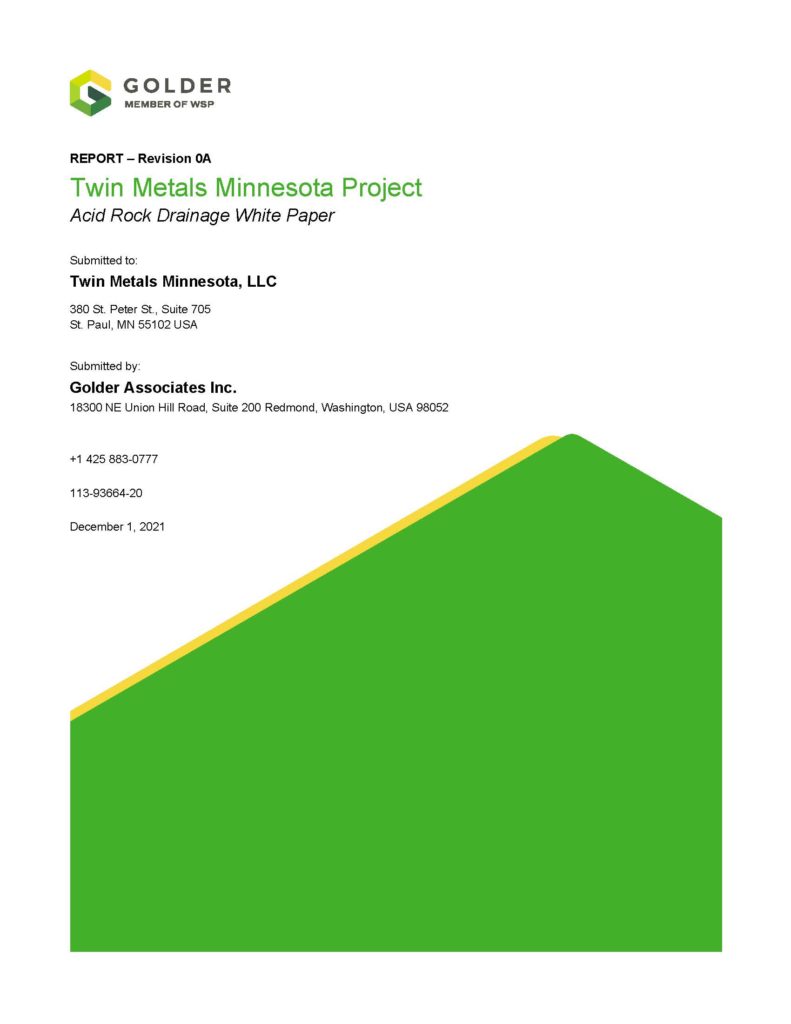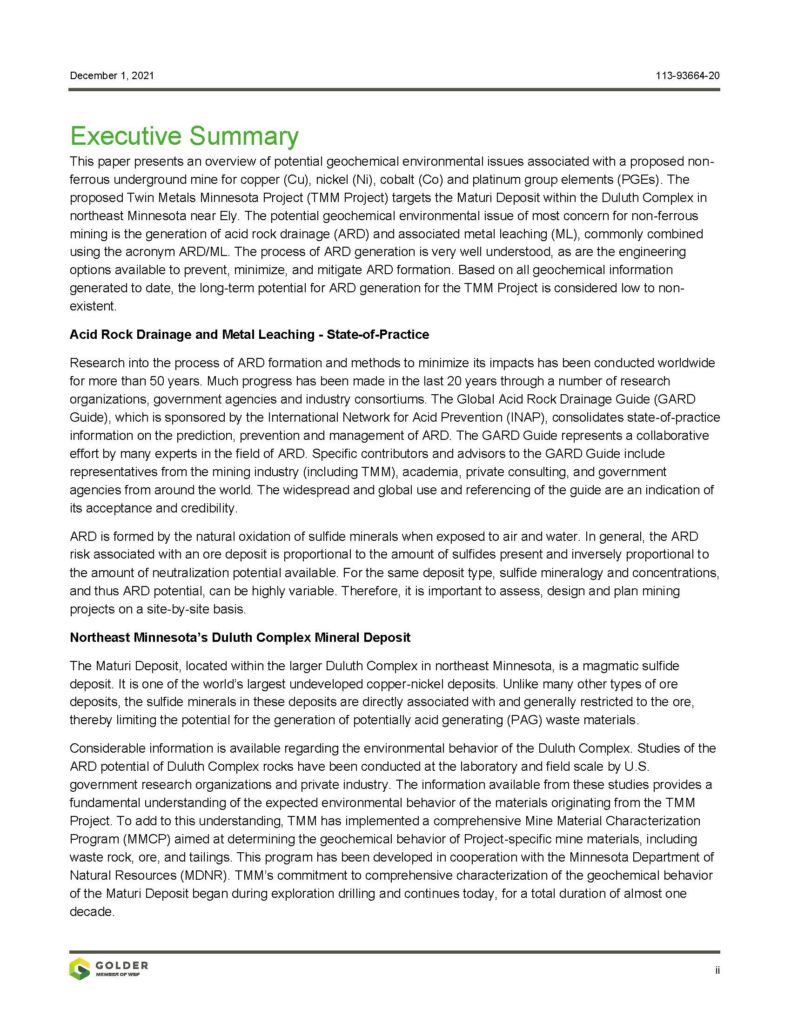FACT: ACID ROCK DRAINAGE IS A NONISSUE WITH THE TWIN METALS MINE
Take a deeper dive to understand a common concern with copper-nickel mining and why it is not relevant for the Twin Metals project
A version of this story appeared in the Duluth News Tribune on January 14, 2022.
If you read local or national media coverage about copper-nickel mining, it’s likely you’ll see references to a concern with this type of mining: the potential for acid rock drainage (ARD). This is something the mining industry takes very seriously. Yet, understanding what it is and how it’s produced requires a deeper dive than the oversimplified surmising and conjectures we too often read about. So, if ARD concerns you too, I urge you to read on.
As an expert on this topic with more than 30 years of experience in the field of mining geochemistry, I believe it’s critical that the public better understand this issue both generally and also how it may or may not apply to individual mining projects.
So, how exactly is ARD created? Some rock naturally contains sulfide minerals. Sulfides are made up of sulfur that is bound to another metal, such as iron, copper or nickel. Weathering or oxidation of sulfide minerals in rocks occurs naturally and can be enhanced when rock is exposed due to mining. When this happens, water that comes in contact with the sulfide rock may then contain higher levels of acidity, sulfate and metals. If not managed properly, this water can affect storm water runoff, snow melt or groundwater quality and cause negative environmental impacts to vegetation or wildlife.
Typically, mining-related ARD is caused by exposure to the elements of sulfide-containing waste rock piles stored on the surface and an absence of appropriate mitigation measures. ARD can also be caused if tailings are high in sulfide content and not properly managed. Waste rock is defined as any rock removed during operations that is undesirable or low grade. Tailings are the leftover finely ground materials after the minerals of economic interest have been physically separated and removed from the ore.
Now, let’s discuss in more detail how waste rock can potentially produce ARD. In open-pit mining, currently the most common method of mining, several tonnes of waste rock are typically removed for every tonne of ore. The waste rock is then placed in piles, often around the open pit. This waste rock can contain elevated levels of sulfide minerals, which could potentially cause ARD if not managed properly. However, modern open pit mines now employ science-based, environmentally protective management plans for waste rock, and they are strictly regulated and monitored by multiple government agencies in the U.S.
With underground mining, which is less common than open pit mining, tunnels are created to strategically target and excavate the ore from deep underground. The best example of this type of mining in Minnesota is the proposed Twin Metals Minnesota underground copper, nickel, cobalt and platinum group metals mine near Ely. With the Twin Metals project, the underground mining method does not require excavation and movement of waste rock in the same manner as does open pit mining. No surface waste rock dumps or stockpiles are required, which means no risk of that material oxidizing. Therefore, the risk of ARD from surface waste facilities is zero.
As mentioned previously, tailings are a second potential source of ARD. It’s important to understand that the geologic makeup of every mineral deposit varies greatly, and a mining operation has to tailor its mineral processing methods based on these variations and the target minerals they’re after. The processing step at a mine involves separating the target minerals from the ore, resulting in a concentrate product that is sold to market. The leftover materials are the tailings. If those tailings have a sufficient sulfide content, they can present ARD issues if unmanaged. Mines with this scenario have to take extra steps to ensure their tailings are managed safely to ensure that ARD does not occur, and regulators strictly govern and monitor how such tailings are handled at every mining operation.
The geology of the Twin Metals deposit is such that the company’s target metals – copper and nickel – occur in the predominant sulfide minerals in the deposit. This is an important qualifier, because it means that during the mineral processing step, these minerals are recovered and report to the concentrate products that are shipped to customers. The financial success of the mining operation depends on recovering the sulfides to the concentrate products for sale, not leaving them in the tailings. As a consequence, the leftover tailings do not contain enough sulfide mineral to create acid, so the ARD risk from this potential source is zero.
When it comes to ARD, which is often cited as the number one concern for copper-nickel mines, it simply has little or no relevance to the Twin Metals project for the reasons identified above. Furthermore, Twin Metals has a host of additional built-in environmental protection measures and innovations that set the project apart as a model mining operation. They’ve adopted dry stack tailings management, considered the most environmentally sustainable tailings storage method, and have committed to investing in research to allow for sequestration of carbon in their tailings. The company has also shifted from a diesel to an electric fleet with a goal of becoming a net zero operation.
We all consume metals in our everyday lives – they’re essential in our cell phones, electric vehicles, infrastructure, electronics, kitchen appliances, medical and clean energy technologies, power transmission, batteries, and so much more. As such, I encourage us all to dig a little deeper into the science and the facts behind our modern mining industry and the companies advancing innovative projects like Twin Metals.
Dr. Rens Verburg is a Principal Geochemist at Golder Associates USA Inc., a member of WSP, with over 30 years of experience in geochemical evaluation of mining issues. He was the Project Director for development of the Global Acid Rock Drainage (GARD) Guide on behalf of the International Network for Acid Prevention. The GARD Guide is a world-wide reference for best practices in prevention of acid rock drainage.



